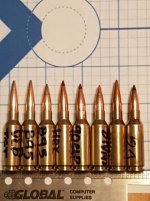Novice reloader here. Couldn't find the the answer to my question on here so posting. I used the Hornady OAL gauge to get my chamber size to lands measurement in my 300 prc. The average was 2.626 and the four measurements were within 3 hundredths. I then measured a factory hornady 212 precision hunter CBTO and got a measurement of 2.821. Is the factory ammo seating .200 in the lands? I've shot the ammo and it's under a minute and shoots pretty decent.
I'm lost on whether this is normal or not. If so, where should I start my seating depth for a velocity test? .02 off my OAL chamber measurement?
I'm lost on whether this is normal or not. If so, where should I start my seating depth for a velocity test? .02 off my OAL chamber measurement?

